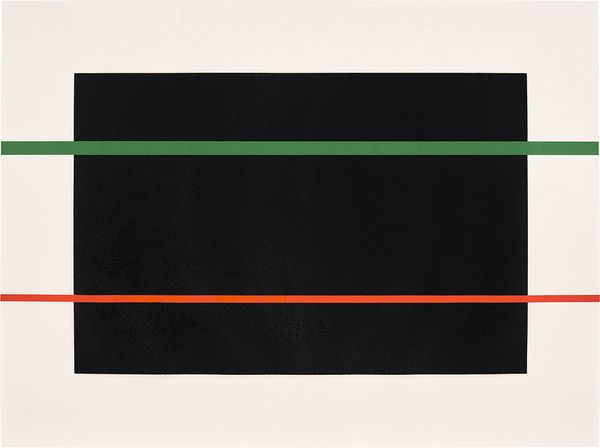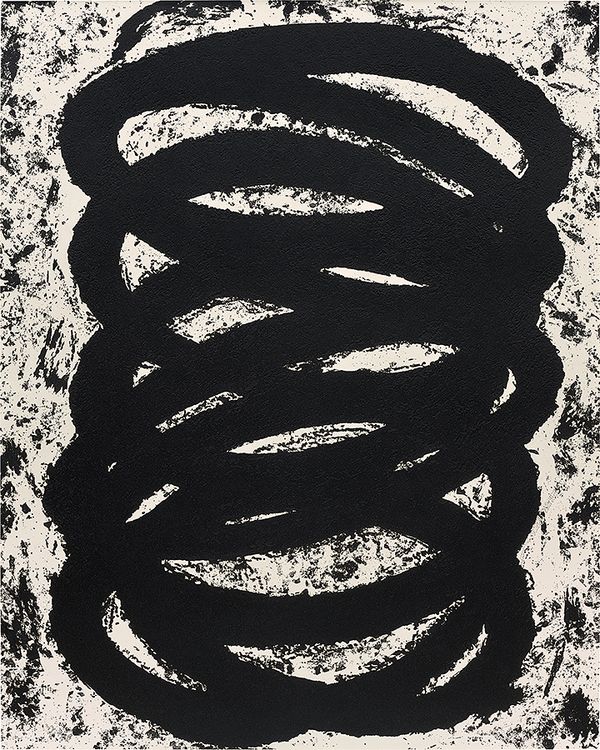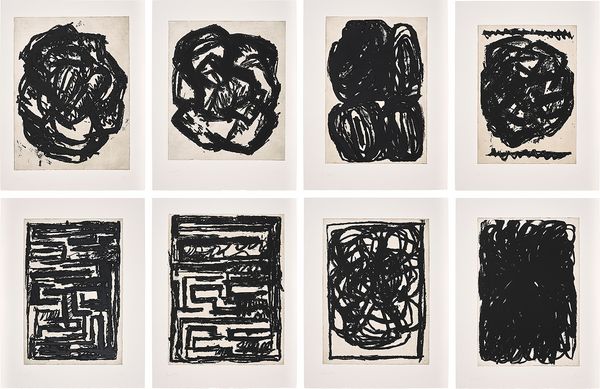Donald Judd, Untitled, 1990. Evening & Day Editions London.
We’re convinced there’s a reason the word line appears in so many core notions of culture and expression. Whether storylines, bloodlines, or bottom lines, the concept seems to capture something essential. Line is the word musicians use for melodies and actors use for dialogue. It’s what we call our professional roles and what we’re taught to form when waiting in public (unless you’re on the side of the pond that prefers to queue). The word also forms the metaphor we use to understand the passage of history or the spatial placement of numbers. And of course, it’s the word for one of the most fundamental elements of art, becoming a kind of visual signature in the hand of a master — when we say, “Picasso’s line” or “Miró’s line,” you know exactly what we mean.
Several works in the upcoming Evening & Day Editions auction showcase the various ways artists have approached line in printmaking, from the gestural to the structural, conceptual, symbolic, and beyond. What’s more, these works primarily rely on black lines or outlines, elevating line to the forefront and holding our gaze through moments of contemplation.
Donald Judd

Donald Judd, Untitled, 1990. Evening & Day Editions London.
With just a precise rectangle and an intersecting line or two, Donald Judd can express on a flat surface the same inquiry of shape and form that we know so well from his three-dimensional works. These prints can be seen to represent the ultimate expression of the artist’s experiments with woodcut that he began in the ‘60s and continued through the ‘90s when these works were executed. On seeing the early woodcuts in Judd’s studio in Marfa, Texas, the Dutch art historian and curator R.H. Fuchs later recalled, “The woodcuts looked radiantly new and highly unorthodox — sober and sparse in form, but the color thick and opulent.” Here, it’s the strong lines that extend beyond the rectangles that lend a remarkable dimensionality to the images. The outlines of the geometric form provide the compositions with structure, while the comparably free intersecting lines open up the picture plane to a rich depth.
Bridget Riley

Bridget Riley, Untitled (Oval Image), 1964. Evening & Day Editions London.
Spatial, hypnotic, energetic, and oozing with the dizzy freedom of the 1960s: we could only be viewing a work by Bridget Riley. In this deceptively complex screenprint, the powerful allure of the ten oval shapes stems from the artist’s careful control over the variance of line weight and alignment. The monochromatic execution of the idea, emblematic of the artist’s works from the time, allows her vigorous manipulation of line to speak freely and directly, lending the work its distinct visual pleasure. To view it is to feel your brain unpack a puzzle, opening new ways of seeing the longer your eyes consider it. Closely associated with the Op Art movement, Riley is primarily interested in the sensation these visual effects elicit, rather than simply experimenting with illusion for illusion’s sake.
Richard Serra

Richard Serra, Finally Finished III, 2018. Evening & Day Editions London.
With a hypnotic presence we can consider in relation to Bridget Riley and showcasing a sculptor’s approach to printmaking akin to Donald Judd, we’re now turning to a work by the uncompromising Richard Serra, who passed away this March at the age of 85. This immense work showcases Serra’s approach to line and its cheeky title captures the artist’s habit of reworking a surface when drawing, remarking that this process helped him to locate himself in the space of an image. The result of the deeply etched copper plate is an almost sculptural print that clearly relates to the artist’s renowned Torqued Ellipses — themselves indicative of Serra’s approach to curved lines. There is a subtle organic nature in the mesmeric and gestural lines that the artist understood well, telling the Brooklyn Rail in 2011, “I think it’s almost impossible to get away from anecdotal ideas or anything that’s figurative if you use a curved line. Any curvilinear line will suggest the figurative or forms in nature, for sure. It’s almost impossible not to imply representation with a curvilinear line, even if it is not intended.”
Mel Bochner

Mel Bochner, 50 Foot Print; and 100 Foot Print, 1997. Evening & Day Editions London.
Lines aren’t just a fundamental element of art; they also make up the everyday symbols and words that govern our way of understanding the world. And for the pioneering conceptual artist Mel Bochner, this has led him to produce a body of work that questions our trust in images, words, and numbers. These two wood engravings at first appear to be gestural clusters of linear arrows. Closer inspection reveals the number twelve (itself a symbol that began as basic lines to represent quantities, evolving into the familiar form we know today) followed by two hash marks. Even the arrows at the ends of the lines are themselves made of lines that echo the length of the hash marks. Of course, we understand these symbols to each denote one foot, but we come to see a discrepancy between the measurements implied and the actual size of the sheets. As Bochner once explained, with his approach, “art would go from being the record of someone else’s perception to becoming the recognition of your own.”
Jannis Kounellis

Jannis Kounellis, The Minotaur, 2003. Evening & Day Editions London.
These eight screenprints with oil base showcase the varieties of ways the Greek artist Jannis Kounellis approached line. They range from the labyrinthian to the gestural, and echo the mythological allusion of the title. Even as screenprints, the works appear painterly, recalling the artist’s own conception of his approach. He once explained: “Everything I do is painting, even if I don’t touch a brush. I tell my truth as a painter.” This line may come as a surprise from a figure who played a major role in the Italian Arte Povera and eventually incorporated a wide range of materials in his exhibitions, including natural substances and even live animals. These eight works speak to us like symbols we don’t yet have the tools to unpack, in an ecstatic celebration of the power of line.
Recommended Reading
Gerhard Richter: Beyond the Paint >
Ancient Symbols, Modern Icons >
